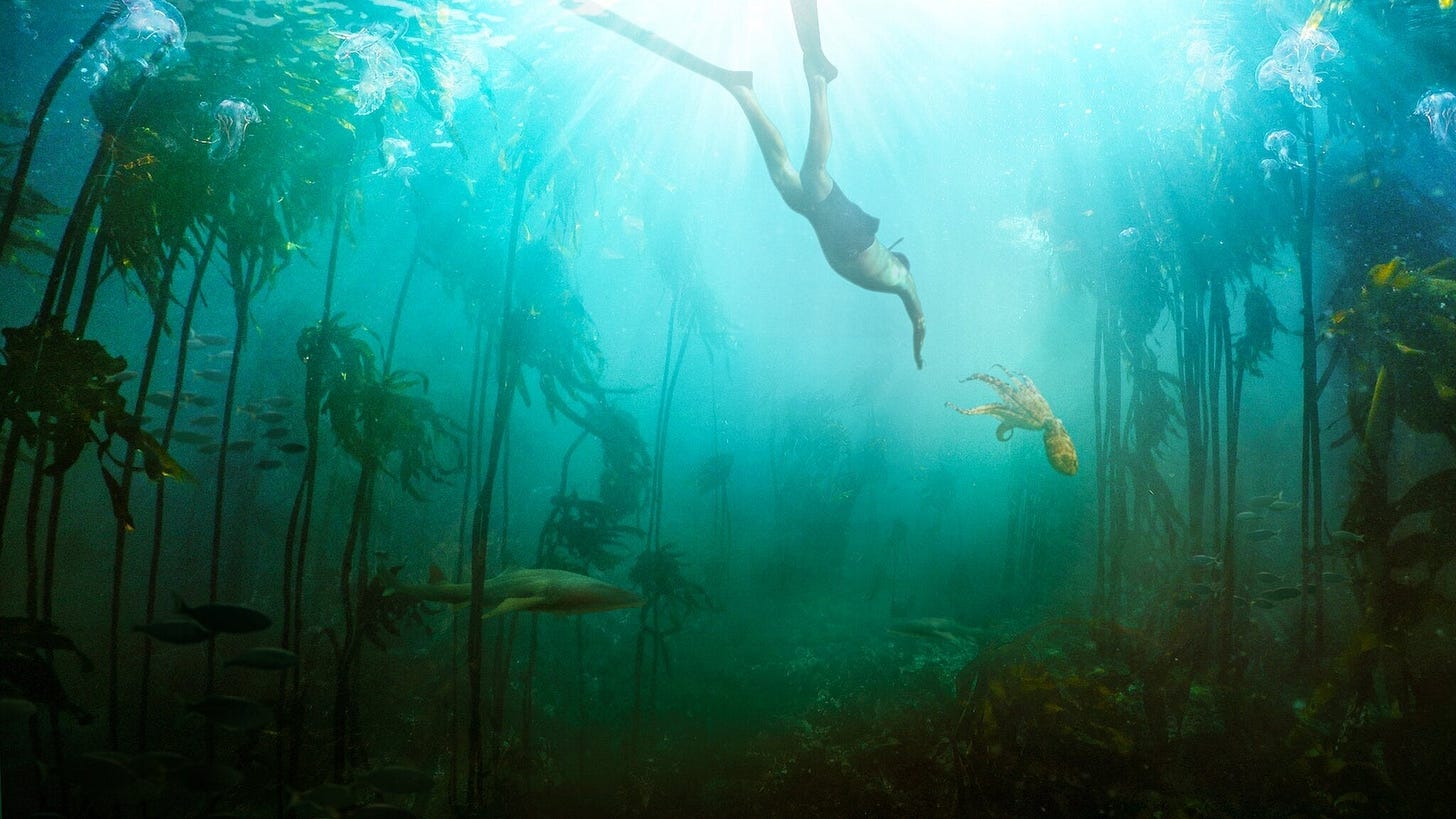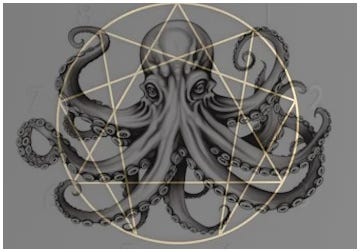The noosphere is picking up something - a new archetype emerging from the deep ocean of the collective unconscious.
- From ‘Octopus Rising’ by Layman Pascal and Octopusyarn
Archetypes are fascinating phenomena. They arise from deep within our collective unconscious to reveal some of our most cherished ideals while also showing us what we often fear. In this way, archetypes are invaluable, embodying symbols that convey meanings almost impossible to put into words.
Layman Pascal has recently teamed up with the author known as Octopusyarn to share their interpretation of a newly emergent archetype rising from the mysterious depths of our psyches: the octopus.
I vividly recall the first time I became aware of just how graceful and intelligent these sea creatures are. It happened when I stumbled upon ‘My Octopus Teacher’ in 2020, and I must admit, I was moved to tears. I can't even remember the last time I cried while watching a movie, especially a documentary. There was something incredibly touching conveyed by the lead star of this film. Was it her elegance, her playfulness, her courage, or most of all, her selfless fortitude? Before I delve into this inquiry, let me attempt to briefly summarize ‘Octopus Rising’ for those of you who haven't read it yet:
While the 'Age of Aquarius' has been unfolding for almost half a century, the authors suggest that the octopus is emerging as a fitting symbol for this new era for several reasons. With its distributed intelligence and complex behaviors, such as flexibility and camouflage, the octopus illustrates the need to transition from individualism to collective intelligence. This shift involves seeing the self as interconnected within social and ecological networks as future organizations are expected to be decentralized and adaptive. The authors go on to highlight that some of the principles for thriving in this new age include multi-perspectival thinking, fluid identity and becoming imperceptible, all of which are useful in an increasingly complex world.1
While these qualities are readily apparent in the fluidity, adaptability, and intelligence of this elusive and majestic sea creature, I would like to introduce another aspect inherent in the octopus, the female octopus to be exact, which I believe is essential for our moving forward into the new era in a generative way.
The Octopus Garden
Every gift comes with a limitation. The octopus symbolizes the existential truth that while multiple perspectives exist, each contributing an essential part to the ever-evolving whole, we must give up something of ourselves to be part of it. Understanding this aspect of reality requires transcending our self-concepts and 'presencing' the relationships being expressed. In my opinion, this kind of selflessness or 'ego-death,' as some spiritual traditions call it, is crucial for coherence and, ultimately, coordination. This process is exemplified by the mother octopus, who devotes all her resources to protecting her eggs, only to sacrifice herself once they hatch.2
I am beginning to notice a subtle yet evident shift in the world, where the mature feminine spirit is emerging as a steady and confident presence. She appears in the fertile void that holds what is possible and nurtures what is necessary into existence. She is not concrete or objectively observable; she is experienced3 and, as such, is elusive, much like an octopus.
As we navigate through the world, I invite us to pay attention to not only what moves us but also how we are moved.4 Where does our curiosity take us?5 Where do we become stuck and intractable?6 And most importantly, what needs to die in order for something new to be reborn?
My hunch is that we will find something of great value7 in the answers to these questions. I anticipate we will discover quality8 and that this discovery will soothe the hunger prevalent in many of us who are enduring a society that favors content over process, ego over presence, and rationality over enchantment.
I am aligning myself with this emergent scene9 from which good contact10 as a part of I/Thou relating arises. Like an octopus coordinating its many arms, each embodying an intelligence of their own, good contact—and the growth that results—is achieved by having the courage to 'loosen our grip' on certainty. This enables us to consider other perspectives and negotiate a path forward that not only appreciates these perspectives, including our own, but also integrates them into a new way of being that is greater than the sum of all perspectives combined. Allowing this process of relating to unfold is an act of faith that requires trust in ourselves, others, and life, itself.
If this scene interests you, let me know. There is an octopus garden waiting. All we need to do is allow ourselves to become a part of it.

Layman Pascal supports these predictions by introducing Gurdjieff in a book he recently published, entitled Gurdjieff for a Time Between Worlds: : Hyperpersonal Essays on the Grandfather of Metamodern Spirituality outlined here on his Substack.
I am pleased to see that Gurdjieff is beginning to be included in the conversation on metamodern spirituality because he said that ‘The Fourth Way’ is a method of self-understanding, but felt that this understanding wasn’t just for ourselves. He asserted that the Enneagram and these teachings are here because the world is at a pivotal point that needed us all to become better acquainted with ourselves and each other. Russ Hudson, author of The Wisdom of the Enneagram, points out that when we're studying the Enneagram in a right way, the quality of presence, of seeing the patterns of our personality, is not a question of resonating with the description of ‘type.’ Rather, the real Enneagram is there to help us see through our self-concepts, to get a deeper sense of what's actually going on in us, so that the real flowering of what we are can come forward. The archetype of the octopus corresponds with this idea. Layman writes: “Here’s Gurdjieff’s famous enneagram with an octopus superimposed:”

In 2018 the Monterey Bay Aquarium Research Institute (MBAR) discovered thousands of octopus nesting on the deep seafloor off the Central California coast:
“Our work has confirmed that pearl octopus (Muusoctopus robustus) migrate to the Octopus Garden to mate and nest. The Octopus Garden is one of a handful of known deep-sea octopus nurseries. At this nursery, warmth from deep-sea thermal springs accelerates the development of octopus eggs.”
The ‘Octopus Garden’ is the largest known aggregation of octopus on the planet. At the near-freezing temperatures of the abyss, pearl octopus eggs are expected to take five to eight years, or more, to hatch. However, these eggs hatchin less than two years. Warmth from thermal springs increased the metabolism of female octopus and their broods, reducing the time required for incubation.
The mature feminine spirit is the “how” to every “what,” and thus, she is relational in the truest sense of the word.
We tend to associate ‘what’ (content) with masculine spirit and ‘how’ (process) with the feminine spirit. In this way, ‘form’ and ‘function’ work together to bring the contours of our lives into focus and thus, allows us re-evaluate and then re-structure how we live.
Tom Morgan’s work centers around curiosity. For more information, please watch The Mystery of Curiosity. I’ll add that the process of knowing and being known constitutes love. Thus, curiosity and love are inextricably woven together.
For more information on the Gestalt completion cycle, please refer to my article Embracing Change.
Iain McGilchrist associates ‘value’ with ‘consciousness’ and Zak Stein takes this concept further by pointing out that ‘intrinsic value’ is centered in nature, out of which all other intrinsic values emerges like beauty, integrity, intimacy and personhood. For more on value, please consider watching ‘Values, Education, AI and the Metacrisis,’ an interview of Zak Stein on The Great Simplification with Nate Hagen.
In Where are all the Women, I point out:
“The masculine inclination to manifest must be balanced by the feminine stance to hold. Because when we strike this balance, we align ourselves with Reality. When we do, we find something of great value. What we find is Quality.
In other words, for our individual and collective actions to be truly life-affirming, we will need to value quality at least as much as quantity. This is where the dance comes in. Engaging in the dance between the masculine and the feminine is how we align ourselves with Life.”
In Sensemaking > Scenemaking, Peter Limberg says:
I am optimistic “scenemaking” can become an emerging art form, with a key condition required: a threshold of people within the scene is virtuous through becoming practically wise. Or less foolish. The art of sensemaking is important and still valuable if done in a way that avoids the egosystem. However, what is more valuable is scenemaking, assuming it is possible to intentionally bring a scenius into existence. While sensemaking helps one make sense of the world, scenemaking will create a world that makes sense to live in.
Good contact is the model of health in Gestalt therapy. I outline this concept in The Power of ‘Now’ and ‘Here.’



